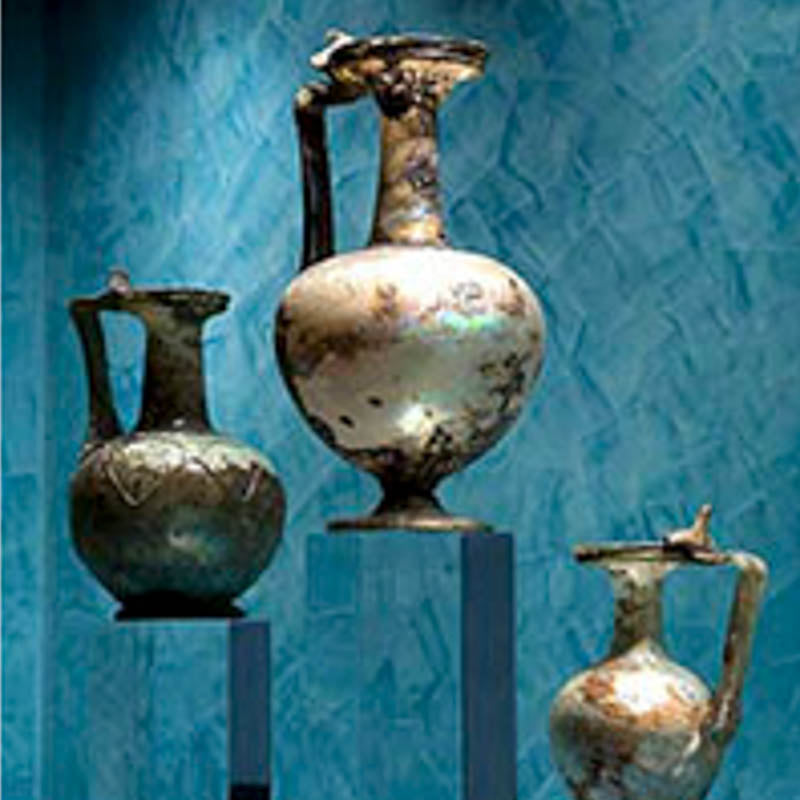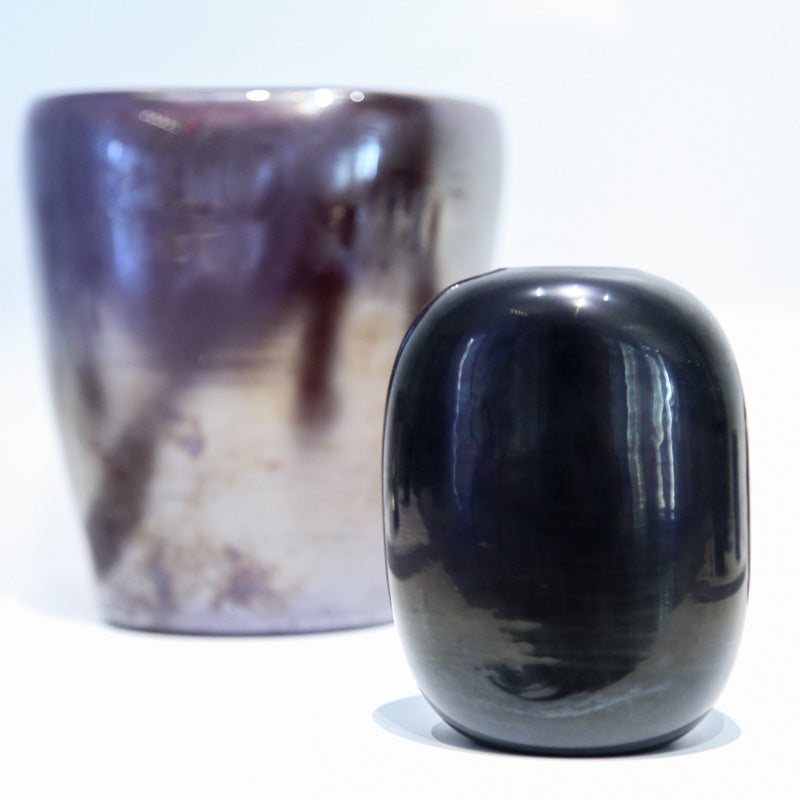In the Tuscan context, the only certain evidence of glass production from the Roman period seems to be the findings in Piazza della Signoria, Florence, which led to the identification of a glassworks that can probably be dated between the end of the 4th and the beginning of the 5th century AD.
Glass flourishes in Tuscany from the 13th century
From the 13th century, evidence of Tuscan glass production became more numerous. Among the many production centres, those of excellence were located in Valdelsa. In the areas of Montaione and Gambassi Terme, in particular, production facilities from the Middle Ages are brought to light, as is the glass workshop of Germagnana, documented in the local permanent exhibition.
Among the most common forms of production are cylindrical or truncated-cone glasses with smooth walls, and moulded glasses with geometric motifs in relief; narrow-necked and globular-bodied bottles and, to a lesser extent, apothecary vials. Less common in this period were chalices and tableware.
From the second half of the 15th century, Tuscan glass is emancipated from Venetian glass
If it is true that in the meantime Venetian production gains the upper hand on a European level, especially thanks to the discovery and perfection of cristallino glass, it is also true that already from the second half of the 15th century, Florentine production undergoes a mutation due to the propaganda program of the ruling house. Nevertheless, it is necessary to reach the beginning of the 17th century to observe a real emancipation from the Murano models in Florentine production.
Under Francesco I, Ferdinando I and Cosimo II, workshops were reorganised and new foundries set up, such as the one in the Casino Mediceo in San Marco, or the one opened in the Boboli Gardens in Florence. Among the new forms of glassware, with a typically mannerist taste, one can observe stem chalices, conical glasses, lidded vases, parade dishes and tableware triumphs (created to amaze and amuse diners), of which there are many.
In the 18th century, glass shapes became sober again. But the demands of the new bourgeoisie influence the market
The 18th century saw a progressive simplification of forms in contrast to the baroque virtuosity of 17th century glass. The new protectionist measures implemented by the Grand Duke, which made the arrival of foreign products or specialised labour extremely difficult, as well as the affirmation of the bourgeoisie, which demanded increasingly refined products in order to approach the opulence of the nobility, pushed Tuscan furnaces to imitate foreign and Venetian fine crystal products.
This is why the activity of factories such as those in Montaione and Colle Val d'Elsa became progressively more important. In 1738, the 'Masters of Montajone' were expressly mentioned in a proclamation issued by Francesco Stefano who, in order to safeguard local production, forbade glassworkers in the area to go and work beyond the borders of the Grand Duchy. Instead, the inauguration of the first furnace for 'crystal' in Colle Val d'Elsa dates back to 1820.
However, this production of an elite nature continues to be flanked by the manufacture of more common pottery, generally of green glass, related to the preservation of agricultural products in the region. In general, this is an artisanal production, carried out by family-run businesses, whose activity remains confined to their own territory.
After the Unification of Italy
A new era of nationalistic protectionism induced the French company Saint Gobain to set up its own branch - which was to be called the Pisan Factory - of mirrors and cast slabs, soon becoming one of the most important in Tuscany, in direct competition with the Società Anonima Vetraria Italiana, founded in Livorno in 1884 and, to a lesser extent, with the firms in Pisa and Florence. While the Fabbrica di Cristallerie e Vetrerie di Colle Val d'Elsa, after Schmid's death in 1885, was going through a period of crisis.
The historical-political-economic upheavals and the artistic and scientific turmoil that characterised the years between 1860 and the first half of the 20th century had a profound effect on glass production of the period. Unfortunately, the loss of much of the documentation and production facilities, especially following the two world wars, made it difficult to draw a correct picture of glass production in Tuscany. An initial period of crisis, due to the high cost of importing raw materials from abroad, was countered in the last two decades of the 19th century by a trend reversal that saw an increase in the range of products, now clearly distinguished between white glass for tableware and apothecary ware and green glass for bottles, flasks and demijohns. The Empolese factories, among which the largest was that of Carlo del Vivo, distinguished themselves in this latter production.
The transition to the new century saw a change in production structures: the factories, which were now industrial in character, were equipped with gas-fired furnaces - invented in 1856 by Friedrich Siemens - and later with semi-automatic machines, such as the Boucher air blowing machine or the Owens mould-making machine. Finally, the newly built railroads, which facilitated the supply of raw materials and the transport of goods, further increased industrial activity in the area.
The new forms of protectionism implemented in the aftermath of the Unification of Italy made it increasingly difficult to import products from abroad, which were now subject to high customs tariffs. It was in this climate that the French government, whose glass was now hardly being sold on the peninsula, decided to remedy the problem by setting up a branch of the Saint Gobain company directly in Pisa. The factory, which took the name Fabbrica Pisana di specchi e lastre colate della Società Saint-Gobain, quickly became one of the most important in Tuscany, in direct competition with the Società Anonima Vetraria Italiana, founded in Livorno in 1884 and, to a lesser extent, with the firms in Pisa and Florence; the Fabbrica di Cristallerie e Vetrerie di Colle Val d'Elsa, on the other hand, was going through a period of crisis after Schmid's death in 1885.
The 900
At the beginning of the 20th century, the crisis in the glass industry affected all the factories on the peninsula, only resolving itself in the period between the two World Wars, when there was a production peak also linked to new experiments that led to the creation, in the 1930s, of innovative materials such as SECURIT (impact-resistant tempered glass produced in Pisa) or VETROFLEX (the most modern thermal insulation of the time, manufactured in Livorno).
Nowadays




Dejar un comentario
Todos los comentarios se revisan antes de su publicación.
Este sitio está protegido por hCaptcha y se aplican la Política de privacidad de hCaptcha y los Términos del servicio.